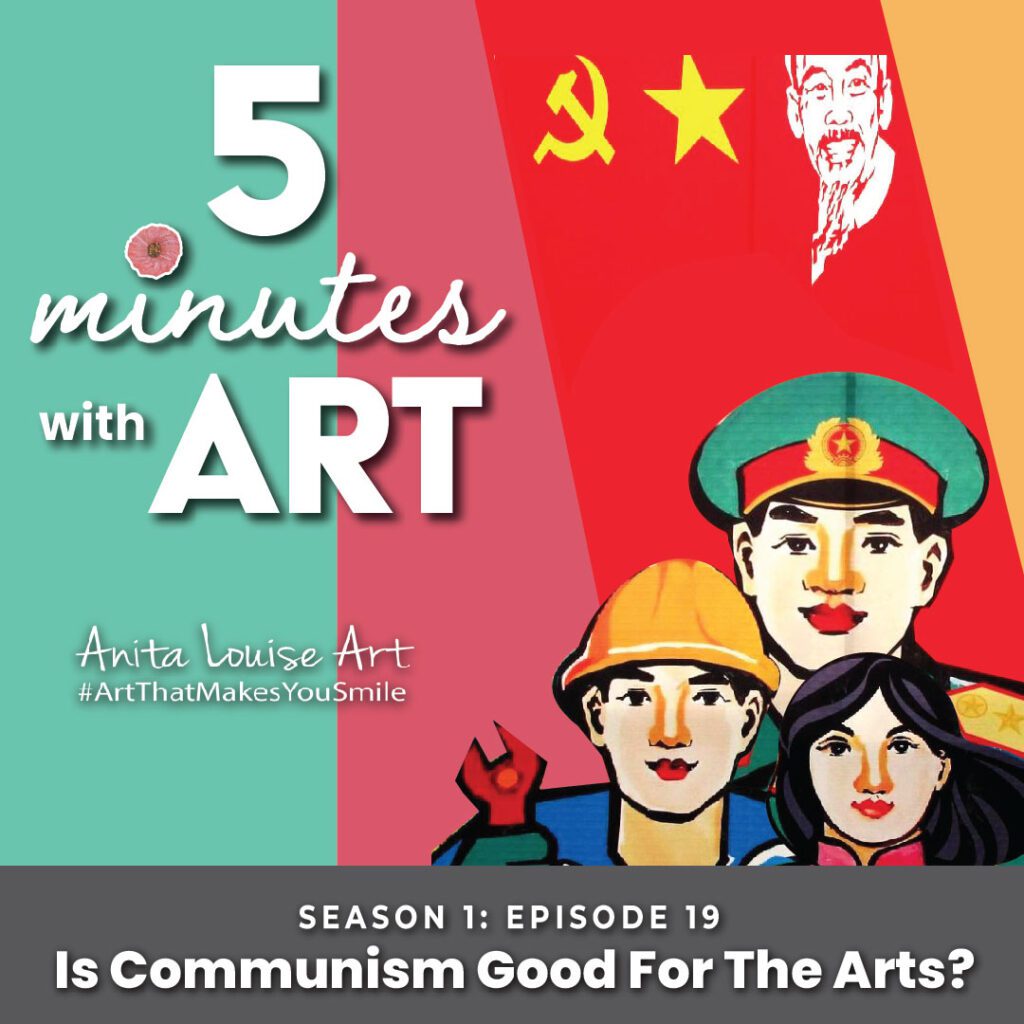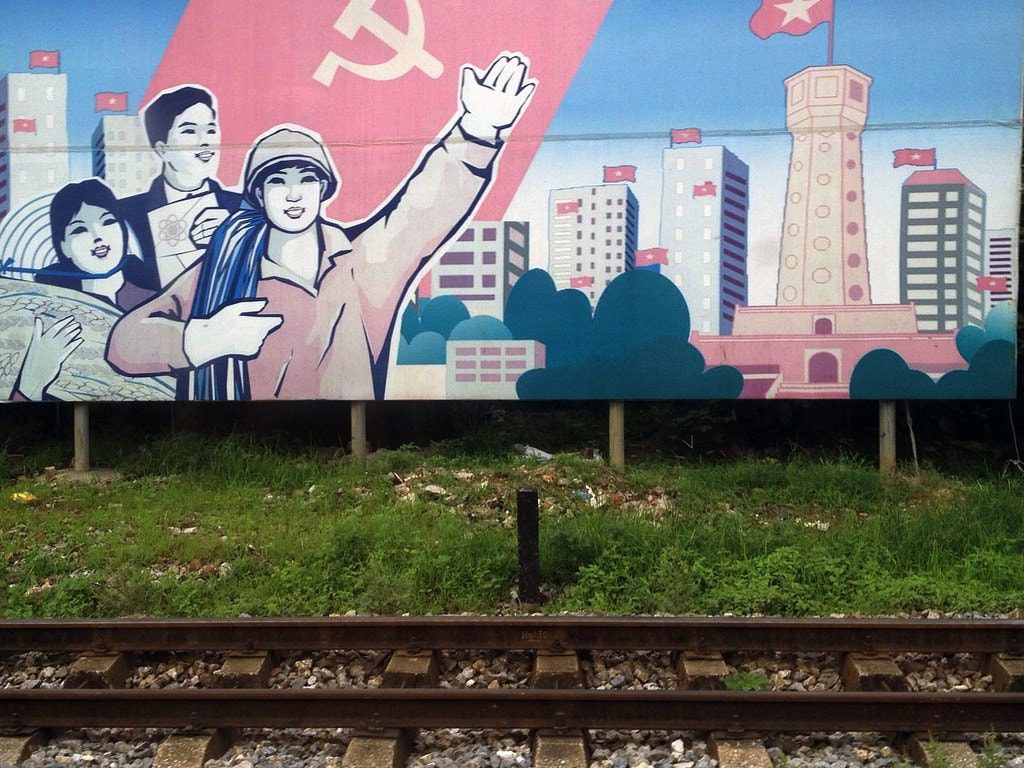I have lived and worked in Communist and Socialist countries (China and Vietnam). It has always fascinated me how Communism and creative art do not always go hand-in-hand.
Communism is not usually suitable for art; living under Communism is difficult for many artists. Art in a communist society should usually have a purpose and way to help further the communist ideals and ideology. In a Communist society, many artists are labeled as dissidents; others are forced to use their talents to create propaganda art.
Table of Contents
- Communism And Art
- Communism And Free Speech
- Propaganda Art And Communism
- Frequently Asked Questions
- Related Questions
Communism And Art
Under Communism, artists, poets, and others were always stifled unless they turned their art and artistic endeavors to what the communist state wanted to see. Artists usually do not have creative freedom as in other countries.
Many artists under Communism refuse to create the art that the communist state wants. If the artists create art the communist state sees as against the state, the artists could be jailed or labeled as “an enemy to the state,”
If you ask the communist leaders, they would tell you that artists have complete and total freedom with their art with the exception ”except it goes against the communist state or government.” The problem is that ”what goes against the communist state or government” is subjective.
The attitude of many Communists is that art is good as long as it helps to further their purpose or work, but the minute it does not, they have no use for it. It was Lenin who famously summed it up by saying this:
I’m no good at art, art for me is a just an appendage, and when its use as propaganda – which we need at the moment – is over, we’ll cut it out as useless: snip, snip!”
Vladimir Lenin
Lenin stated what many communist societies believe – art needs to have a purpose and be a way to bring society toward communist ideals.
Communism And Free Speech
One of the critical aspects of Communism is the aspect of freedom of speech. In a Communist society, the individual’s best interests should align with the communist society.
The idea of individual freedom is not compatible with Communist thinking and ideology. Under Communism, the reason to have freedom of speech and personal freedoms would be to bring forth the communist ideals and ideology.
Even though this is the practice, it is interesting to note that under Communism, one of the tenets or beliefs is that under Communism, each individual’s rights are as necessary as the other person’s. That is why in many communist constitutions, you may find that ”freedom of speech” and ”expression” are listed as guiding principles ”except it goes against the state.”
In other words, under Communism, you are said to have freedom as long as it follows the Communist ideology and thought.
This is where it becomes messy and complex for artists who are living in a Communist state. Artistic freedom is about the freedom to express yourself, but under Communism, your creative freedom could be viewed as going against the state and, therefore, anti-Communist.

Listen To Our Podcast About Is Communism Good For The Arts? by clicking here.
In many Communist countries, artists who believed in free expression were jailed and labeled as dissidents as the state felt their art went against the ideology of Communism or a Communist state. The problem is that “what goes against the Communist state” is very subjective under Communism. Some artists may be jailed just for being artists, whereas others were jailed as their art had hidden meanings or was dissident art.
The reality is that under Communism, there is no free speech. As such, artists are one group of people traditionally targeted in a Communist regime as dissidents. The Communist state desires to silence the artists, even sending them to jail.
Propaganda Art And Communism
The one kind of art that has consistently thrived under Communism is propaganda art. Even today, on the streets of Hanoi, you can see these famous propaganda art posters all over the country.

The purpose of the propaganda art was for the communist state to use art to communicate to the population. This art was readily accepted as art that had a purpose and was viewed as actively furthering the Communist ideology.
Under Communism, all art was a form of propaganda. This includes literature, visual arts, and even performing arts.
The purpose of the art was to show the unambiguous meaning of how Communism was the ideal. Art for creating art was not the purpose here, but it was an art to give a message of the glories of the Communist ideology and objectives.
For the artist, the art was not for them to create or even show off their artistic skills, but more for them to show the population the ideals and ideology of a communist society. That is why some of the art may be ill-executed when you look at this propaganda art from a purely artistic view.
Under Communism, the artist’s talent did not matter as much as the artist using that talent, whatever they had to further the Communist ideals. It was not about the artist having to create anything unique or new but instead being able to follow the directives given to them when they produced the art.
Anita Louise Art is dedicated to art education, great artists, and inspiring others to find and create their art. We love art that uplifts and inspires. #ArtToMakeYouSmile! #ArtToMakeYouHappy!
If you are interested in seeing any of my art, you can find out more by clicking here. If you are interested in what inspires me and my paintings, you can discover more by clicking here.
We have a free newsletter and would love you to be part of our community; you can subscribe to the newsletter by clicking here. If you have any questions, I would be happy to talk to you. You can reach me, Anita, by clicking here.
Subscribe to our Anita Louise Art YouTube Channel filled with great videos and information by clicking here.
Join us for our podcast “5 Minutes With Art.” Spend just 5 minutes a week with us to discover and learn about great art and artists. You can find out more about our podcast by clicking here.
Frequently Asked Questions
Is communism generally supportive of artistic expression?
While communism advocates for collective ideals, artistic expression can be constrained in communist societies. Art is often expected to align with and promote the principles of communism.
How does communism impact the freedom of artistic expression?
Communism can limit artistic freedom as art is expected to serve the ideological goals of the state. Artists may face restrictions on themes, styles, and content to ensure alignment with communist ideals.
Are there instances where artists face challenges or persecution in communist societies?
Yes, many artists in communist societies may be labeled as dissidents or face persecution if their work diverges from the prescribed narrative, challenging the status quo.
Can artists under communism create art solely for personal expression?
Creating art solely for personal expression may be challenging in a communist context, as the emphasis often lies on art contributing to the collective good or promoting communist ideology.
How does communism influence the subject matter of artistic works?
Communist societies often expect art to depict themes that align with the goals of the state, such as glorifying the working class, promoting solidarity, and advancing socialist ideals.
Are there opportunities for dissenting voices within the artistic community in communist countries?
Dissenting voices in the artistic community of communist countries may face censorship, suppression, or even punishment, making it difficult for alternative perspectives to flourish.
Can artists choose to remain apolitical in a communist society?
Remaining apolitical in a communist society can be challenging, as art is often expected to contribute to the larger political narrative or societal goals.
Do communist societies encourage specific art forms over others?
Communist societies may prioritize certain art forms that align more closely with their ideological goals, such as propaganda art or art that serves a utilitarian purpose.
How do communist governments view the role of artists in society?
Communist governments often see artists as contributors to the shaping of public opinion and may expect them to play a role in promoting the ideology and values of the state.
Are there any historical examples of successful artistic expression within communism?
While there are instances of artists producing impactful works in communist societies, success is often measured by how well the art aligns with the prevailing ideology, and dissenting voices may not be widely celebrated.
Related Questions
What is Art? What Does Art Mean To You?
Art is about the human creative skills and imagination that usually come out in a creative visual form; art such as painting, sculpturing, and photography are all visual art forms. Art should matter to society as it is through art that the creator of the art and the viewer of the art can gain new and rich understandings bout themselves, their lives, history, and society.
By clicking here, you can learn more by reading What is Art? What Does Art Mean To You?.
Why Do People Say, ”Life Is Like Drawing Without An Eraser?
Many times, artists, myself included, will use an eraser to remove any marks or measurements we may have made on a paper to measure out and organize their drawings or artwork on their canvas or paper. For most artists having a good eraser is essential.
By clicking here, you can learn more by reading Why Do People Say, ”Life Is Like Drawing Without An Eraser?.
Meaning Of “Art Speaks Where Words Are Unable To Explain”
“Art speaks where words are unable to explain” means that words, even though very powerful, and not always able to convey the message as Art can convey it. Words are powerful, but an image or piece of art can be much more potent than the spoken or written word.
By clicking here, you can learn more by reading Meaning Of “Art Speaks Where Words Are Unable To Explain”.

